Circular Economy: Principles, Benefits, Barriers and Examples
VerifiedAdded on 2021/08/23
|10
|3357
|143
Essay
AI Summary
This essay provides a comprehensive overview of the circular economy, contrasting it with the linear economy and highlighting its principles of waste elimination, material reuse, and regeneration of natural systems. It examines the benefits, including reduced waste, resource optimization, and economic opportunities, while also addressing the barriers to implementation, such as economic, institutional, and technological challenges. The essay delves into the principles of designing out waste, keeping products and materials in use, and regenerating natural systems. It further explores real-world examples, such as the use of recycled materials, and discusses the importance of environmental benefits like lowering greenhouse gas emissions and the need for effective life cycle management and industrial collaboration to achieve a truly circular model. The essay emphasizes the need for a systemic shift, incorporating a long-term vision and addressing challenges related to efficient life cycle control, industrial resilience, and environmental impact to achieve a sustainable and profitable circular economy.
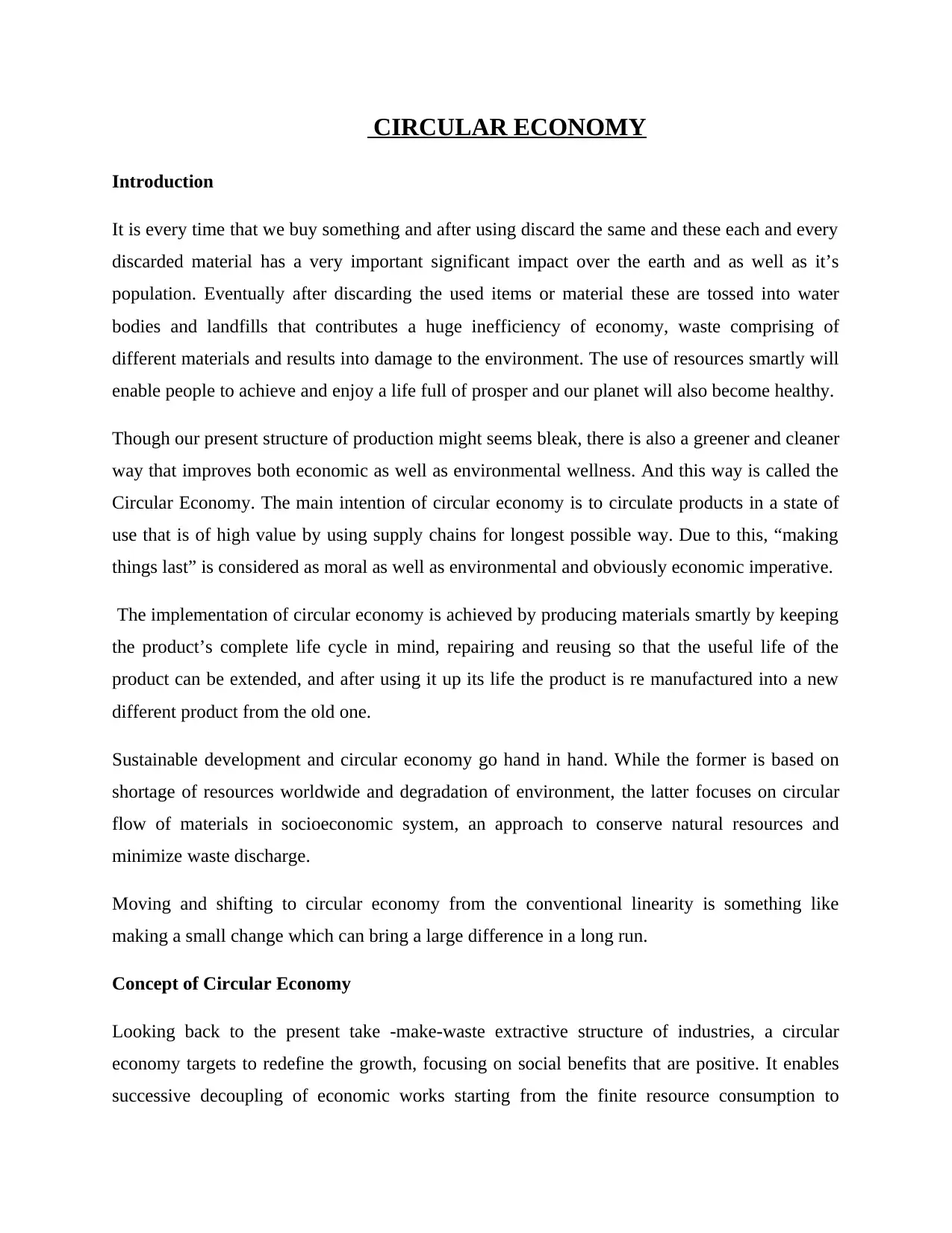
CIRCULAR ECONOMY
Introduction
It is every time that we buy something and after using discard the same and these each and every
discarded material has a very important significant impact over the earth and as well as it’s
population. Eventually after discarding the used items or material these are tossed into water
bodies and landfills that contributes a huge inefficiency of economy, waste comprising of
different materials and results into damage to the environment. The use of resources smartly will
enable people to achieve and enjoy a life full of prosper and our planet will also become healthy.
Though our present structure of production might seems bleak, there is also a greener and cleaner
way that improves both economic as well as environmental wellness. And this way is called the
Circular Economy. The main intention of circular economy is to circulate products in a state of
use that is of high value by using supply chains for longest possible way. Due to this, “making
things last” is considered as moral as well as environmental and obviously economic imperative.
The implementation of circular economy is achieved by producing materials smartly by keeping
the product’s complete life cycle in mind, repairing and reusing so that the useful life of the
product can be extended, and after using it up its life the product is re manufactured into a new
different product from the old one.
Sustainable development and circular economy go hand in hand. While the former is based on
shortage of resources worldwide and degradation of environment, the latter focuses on circular
flow of materials in socioeconomic system, an approach to conserve natural resources and
minimize waste discharge.
Moving and shifting to circular economy from the conventional linearity is something like
making a small change which can bring a large difference in a long run.
Concept of Circular Economy
Looking back to the present take -make-waste extractive structure of industries, a circular
economy targets to redefine the growth, focusing on social benefits that are positive. It enables
successive decoupling of economic works starting from the finite resource consumption to
Introduction
It is every time that we buy something and after using discard the same and these each and every
discarded material has a very important significant impact over the earth and as well as it’s
population. Eventually after discarding the used items or material these are tossed into water
bodies and landfills that contributes a huge inefficiency of economy, waste comprising of
different materials and results into damage to the environment. The use of resources smartly will
enable people to achieve and enjoy a life full of prosper and our planet will also become healthy.
Though our present structure of production might seems bleak, there is also a greener and cleaner
way that improves both economic as well as environmental wellness. And this way is called the
Circular Economy. The main intention of circular economy is to circulate products in a state of
use that is of high value by using supply chains for longest possible way. Due to this, “making
things last” is considered as moral as well as environmental and obviously economic imperative.
The implementation of circular economy is achieved by producing materials smartly by keeping
the product’s complete life cycle in mind, repairing and reusing so that the useful life of the
product can be extended, and after using it up its life the product is re manufactured into a new
different product from the old one.
Sustainable development and circular economy go hand in hand. While the former is based on
shortage of resources worldwide and degradation of environment, the latter focuses on circular
flow of materials in socioeconomic system, an approach to conserve natural resources and
minimize waste discharge.
Moving and shifting to circular economy from the conventional linearity is something like
making a small change which can bring a large difference in a long run.
Concept of Circular Economy
Looking back to the present take -make-waste extractive structure of industries, a circular
economy targets to redefine the growth, focusing on social benefits that are positive. It enables
successive decoupling of economic works starting from the finite resource consumption to
Paraphrase This Document
Need a fresh take? Get an instant paraphrase of this document with our AI Paraphraser
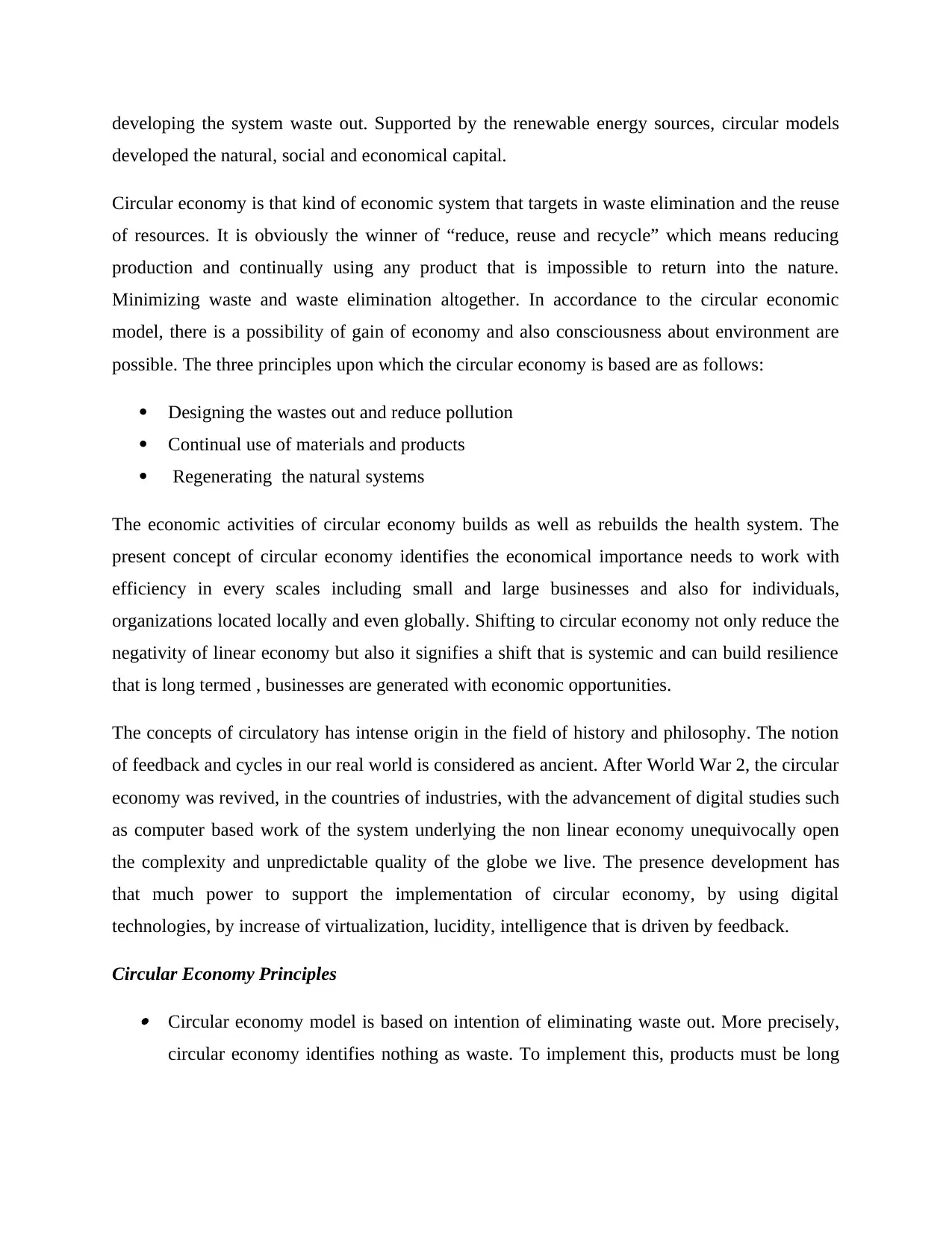
developing the system waste out. Supported by the renewable energy sources, circular models
developed the natural, social and economical capital.
Circular economy is that kind of economic system that targets in waste elimination and the reuse
of resources. It is obviously the winner of “reduce, reuse and recycle” which means reducing
production and continually using any product that is impossible to return into the nature.
Minimizing waste and waste elimination altogether. In accordance to the circular economic
model, there is a possibility of gain of economy and also consciousness about environment are
possible. The three principles upon which the circular economy is based are as follows:
Designing the wastes out and reduce pollution
Continual use of materials and products
Regenerating the natural systems
The economic activities of circular economy builds as well as rebuilds the health system. The
present concept of circular economy identifies the economical importance needs to work with
efficiency in every scales including small and large businesses and also for individuals,
organizations located locally and even globally. Shifting to circular economy not only reduce the
negativity of linear economy but also it signifies a shift that is systemic and can build resilience
that is long termed , businesses are generated with economic opportunities.
The concepts of circulatory has intense origin in the field of history and philosophy. The notion
of feedback and cycles in our real world is considered as ancient. After World War 2, the circular
economy was revived, in the countries of industries, with the advancement of digital studies such
as computer based work of the system underlying the non linear economy unequivocally open
the complexity and unpredictable quality of the globe we live. The presence development has
that much power to support the implementation of circular economy, by using digital
technologies, by increase of virtualization, lucidity, intelligence that is driven by feedback.
Circular Economy Principles
Circular economy model is based on intention of eliminating waste out. More precisely,
circular economy identifies nothing as waste. To implement this, products must be long
developed the natural, social and economical capital.
Circular economy is that kind of economic system that targets in waste elimination and the reuse
of resources. It is obviously the winner of “reduce, reuse and recycle” which means reducing
production and continually using any product that is impossible to return into the nature.
Minimizing waste and waste elimination altogether. In accordance to the circular economic
model, there is a possibility of gain of economy and also consciousness about environment are
possible. The three principles upon which the circular economy is based are as follows:
Designing the wastes out and reduce pollution
Continual use of materials and products
Regenerating the natural systems
The economic activities of circular economy builds as well as rebuilds the health system. The
present concept of circular economy identifies the economical importance needs to work with
efficiency in every scales including small and large businesses and also for individuals,
organizations located locally and even globally. Shifting to circular economy not only reduce the
negativity of linear economy but also it signifies a shift that is systemic and can build resilience
that is long termed , businesses are generated with economic opportunities.
The concepts of circulatory has intense origin in the field of history and philosophy. The notion
of feedback and cycles in our real world is considered as ancient. After World War 2, the circular
economy was revived, in the countries of industries, with the advancement of digital studies such
as computer based work of the system underlying the non linear economy unequivocally open
the complexity and unpredictable quality of the globe we live. The presence development has
that much power to support the implementation of circular economy, by using digital
technologies, by increase of virtualization, lucidity, intelligence that is driven by feedback.
Circular Economy Principles
Circular economy model is based on intention of eliminating waste out. More precisely,
circular economy identifies nothing as waste. To implement this, products must be long
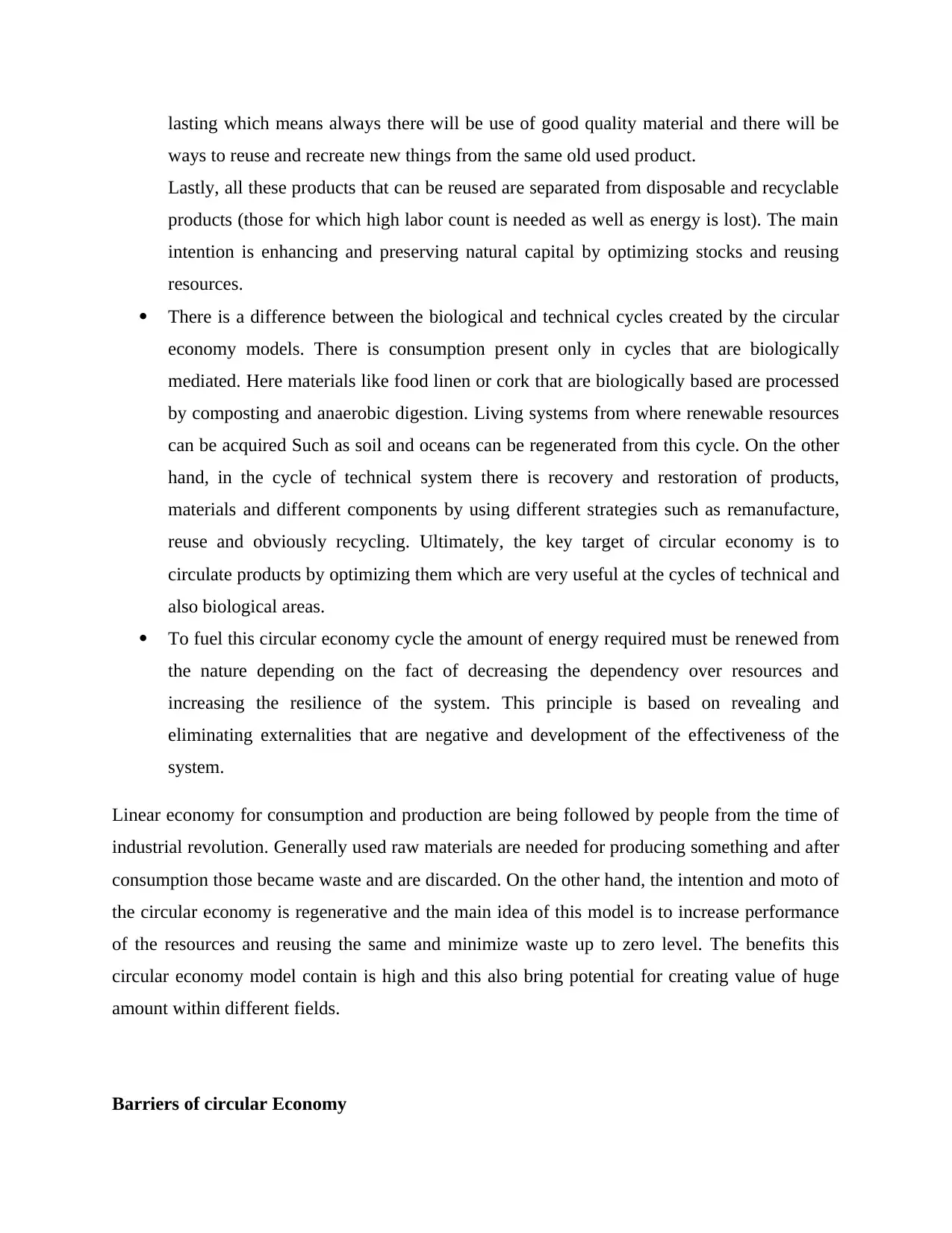
lasting which means always there will be use of good quality material and there will be
ways to reuse and recreate new things from the same old used product.
Lastly, all these products that can be reused are separated from disposable and recyclable
products (those for which high labor count is needed as well as energy is lost). The main
intention is enhancing and preserving natural capital by optimizing stocks and reusing
resources.
There is a difference between the biological and technical cycles created by the circular
economy models. There is consumption present only in cycles that are biologically
mediated. Here materials like food linen or cork that are biologically based are processed
by composting and anaerobic digestion. Living systems from where renewable resources
can be acquired Such as soil and oceans can be regenerated from this cycle. On the other
hand, in the cycle of technical system there is recovery and restoration of products,
materials and different components by using different strategies such as remanufacture,
reuse and obviously recycling. Ultimately, the key target of circular economy is to
circulate products by optimizing them which are very useful at the cycles of technical and
also biological areas.
To fuel this circular economy cycle the amount of energy required must be renewed from
the nature depending on the fact of decreasing the dependency over resources and
increasing the resilience of the system. This principle is based on revealing and
eliminating externalities that are negative and development of the effectiveness of the
system.
Linear economy for consumption and production are being followed by people from the time of
industrial revolution. Generally used raw materials are needed for producing something and after
consumption those became waste and are discarded. On the other hand, the intention and moto of
the circular economy is regenerative and the main idea of this model is to increase performance
of the resources and reusing the same and minimize waste up to zero level. The benefits this
circular economy model contain is high and this also bring potential for creating value of huge
amount within different fields.
Barriers of circular Economy
ways to reuse and recreate new things from the same old used product.
Lastly, all these products that can be reused are separated from disposable and recyclable
products (those for which high labor count is needed as well as energy is lost). The main
intention is enhancing and preserving natural capital by optimizing stocks and reusing
resources.
There is a difference between the biological and technical cycles created by the circular
economy models. There is consumption present only in cycles that are biologically
mediated. Here materials like food linen or cork that are biologically based are processed
by composting and anaerobic digestion. Living systems from where renewable resources
can be acquired Such as soil and oceans can be regenerated from this cycle. On the other
hand, in the cycle of technical system there is recovery and restoration of products,
materials and different components by using different strategies such as remanufacture,
reuse and obviously recycling. Ultimately, the key target of circular economy is to
circulate products by optimizing them which are very useful at the cycles of technical and
also biological areas.
To fuel this circular economy cycle the amount of energy required must be renewed from
the nature depending on the fact of decreasing the dependency over resources and
increasing the resilience of the system. This principle is based on revealing and
eliminating externalities that are negative and development of the effectiveness of the
system.
Linear economy for consumption and production are being followed by people from the time of
industrial revolution. Generally used raw materials are needed for producing something and after
consumption those became waste and are discarded. On the other hand, the intention and moto of
the circular economy is regenerative and the main idea of this model is to increase performance
of the resources and reusing the same and minimize waste up to zero level. The benefits this
circular economy model contain is high and this also bring potential for creating value of huge
amount within different fields.
Barriers of circular Economy
⊘ This is a preview!⊘
Do you want full access?
Subscribe today to unlock all pages.

Trusted by 1+ million students worldwide
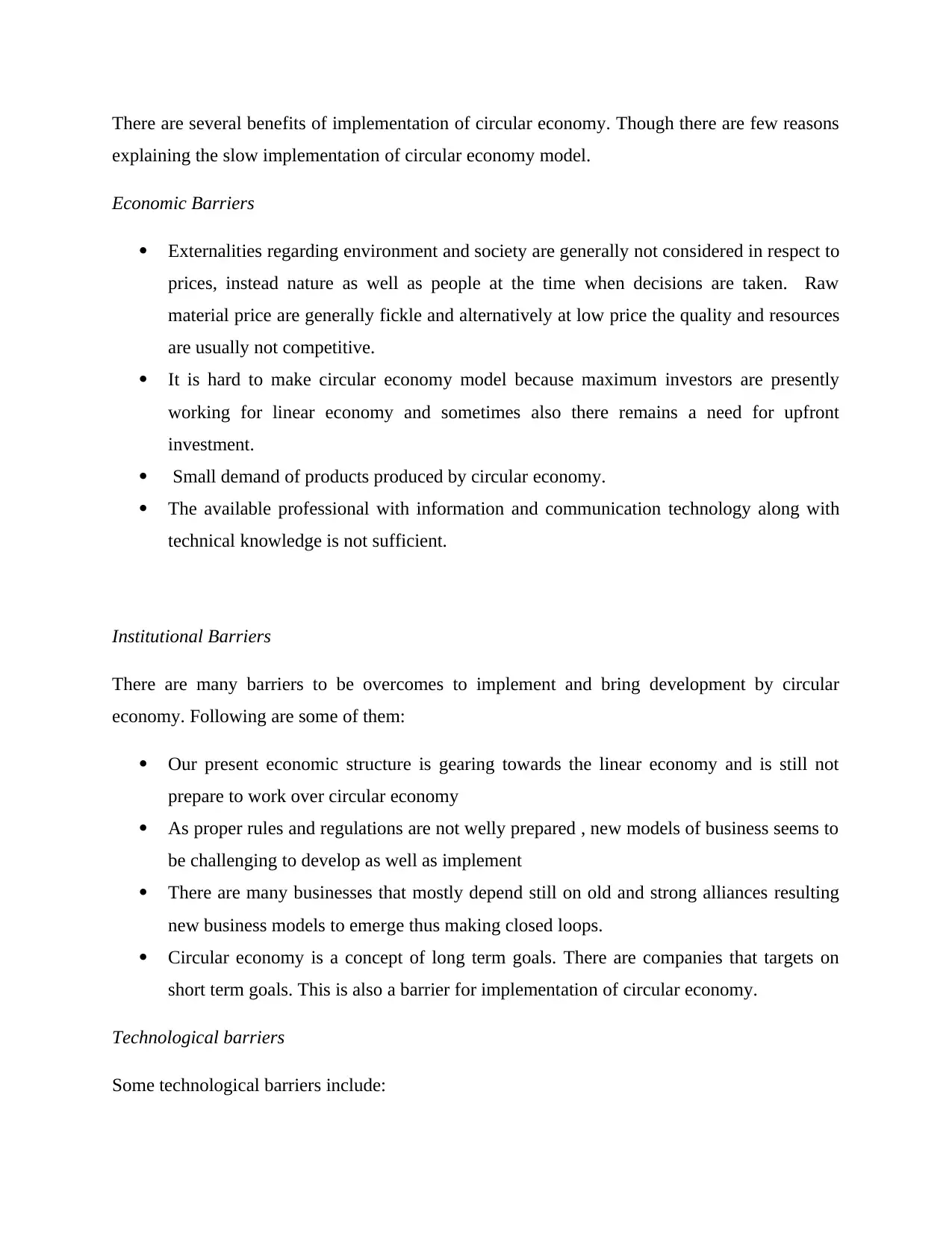
There are several benefits of implementation of circular economy. Though there are few reasons
explaining the slow implementation of circular economy model.
Economic Barriers
Externalities regarding environment and society are generally not considered in respect to
prices, instead nature as well as people at the time when decisions are taken. Raw
material price are generally fickle and alternatively at low price the quality and resources
are usually not competitive.
It is hard to make circular economy model because maximum investors are presently
working for linear economy and sometimes also there remains a need for upfront
investment.
Small demand of products produced by circular economy.
The available professional with information and communication technology along with
technical knowledge is not sufficient.
Institutional Barriers
There are many barriers to be overcomes to implement and bring development by circular
economy. Following are some of them:
Our present economic structure is gearing towards the linear economy and is still not
prepare to work over circular economy
As proper rules and regulations are not welly prepared , new models of business seems to
be challenging to develop as well as implement
There are many businesses that mostly depend still on old and strong alliances resulting
new business models to emerge thus making closed loops.
Circular economy is a concept of long term goals. There are companies that targets on
short term goals. This is also a barrier for implementation of circular economy.
Technological barriers
Some technological barriers include:
explaining the slow implementation of circular economy model.
Economic Barriers
Externalities regarding environment and society are generally not considered in respect to
prices, instead nature as well as people at the time when decisions are taken. Raw
material price are generally fickle and alternatively at low price the quality and resources
are usually not competitive.
It is hard to make circular economy model because maximum investors are presently
working for linear economy and sometimes also there remains a need for upfront
investment.
Small demand of products produced by circular economy.
The available professional with information and communication technology along with
technical knowledge is not sufficient.
Institutional Barriers
There are many barriers to be overcomes to implement and bring development by circular
economy. Following are some of them:
Our present economic structure is gearing towards the linear economy and is still not
prepare to work over circular economy
As proper rules and regulations are not welly prepared , new models of business seems to
be challenging to develop as well as implement
There are many businesses that mostly depend still on old and strong alliances resulting
new business models to emerge thus making closed loops.
Circular economy is a concept of long term goals. There are companies that targets on
short term goals. This is also a barrier for implementation of circular economy.
Technological barriers
Some technological barriers include:
Paraphrase This Document
Need a fresh take? Get an instant paraphrase of this document with our AI Paraphraser
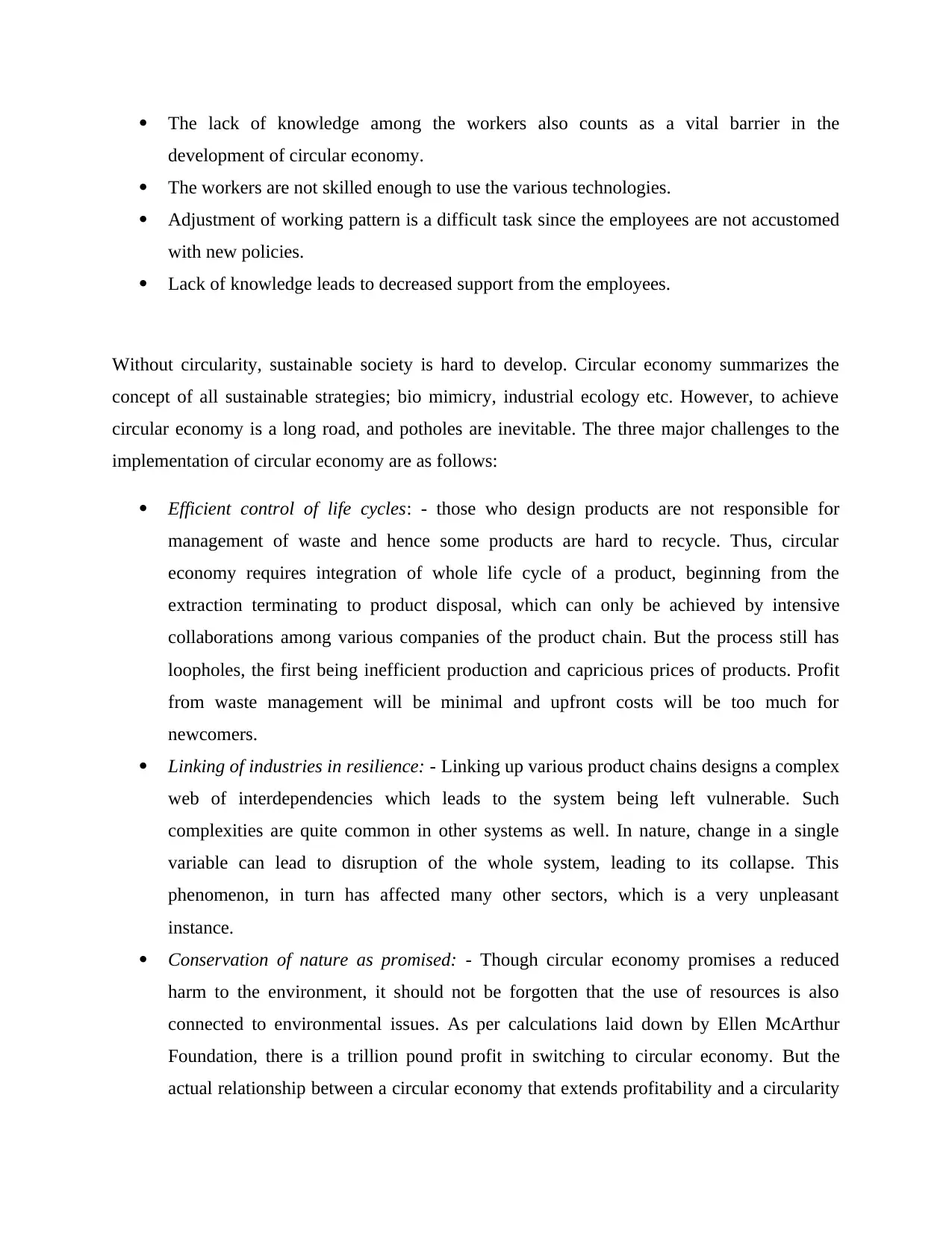
The lack of knowledge among the workers also counts as a vital barrier in the
development of circular economy.
The workers are not skilled enough to use the various technologies.
Adjustment of working pattern is a difficult task since the employees are not accustomed
with new policies.
Lack of knowledge leads to decreased support from the employees.
Without circularity, sustainable society is hard to develop. Circular economy summarizes the
concept of all sustainable strategies; bio mimicry, industrial ecology etc. However, to achieve
circular economy is a long road, and potholes are inevitable. The three major challenges to the
implementation of circular economy are as follows:
Efficient control of life cycles: - those who design products are not responsible for
management of waste and hence some products are hard to recycle. Thus, circular
economy requires integration of whole life cycle of a product, beginning from the
extraction terminating to product disposal, which can only be achieved by intensive
collaborations among various companies of the product chain. But the process still has
loopholes, the first being inefficient production and capricious prices of products. Profit
from waste management will be minimal and upfront costs will be too much for
newcomers.
Linking of industries in resilience: - Linking up various product chains designs a complex
web of interdependencies which leads to the system being left vulnerable. Such
complexities are quite common in other systems as well. In nature, change in a single
variable can lead to disruption of the whole system, leading to its collapse. This
phenomenon, in turn has affected many other sectors, which is a very unpleasant
instance.
Conservation of nature as promised: - Though circular economy promises a reduced
harm to the environment, it should not be forgotten that the use of resources is also
connected to environmental issues. As per calculations laid down by Ellen McArthur
Foundation, there is a trillion pound profit in switching to circular economy. But the
actual relationship between a circular economy that extends profitability and a circularity
development of circular economy.
The workers are not skilled enough to use the various technologies.
Adjustment of working pattern is a difficult task since the employees are not accustomed
with new policies.
Lack of knowledge leads to decreased support from the employees.
Without circularity, sustainable society is hard to develop. Circular economy summarizes the
concept of all sustainable strategies; bio mimicry, industrial ecology etc. However, to achieve
circular economy is a long road, and potholes are inevitable. The three major challenges to the
implementation of circular economy are as follows:
Efficient control of life cycles: - those who design products are not responsible for
management of waste and hence some products are hard to recycle. Thus, circular
economy requires integration of whole life cycle of a product, beginning from the
extraction terminating to product disposal, which can only be achieved by intensive
collaborations among various companies of the product chain. But the process still has
loopholes, the first being inefficient production and capricious prices of products. Profit
from waste management will be minimal and upfront costs will be too much for
newcomers.
Linking of industries in resilience: - Linking up various product chains designs a complex
web of interdependencies which leads to the system being left vulnerable. Such
complexities are quite common in other systems as well. In nature, change in a single
variable can lead to disruption of the whole system, leading to its collapse. This
phenomenon, in turn has affected many other sectors, which is a very unpleasant
instance.
Conservation of nature as promised: - Though circular economy promises a reduced
harm to the environment, it should not be forgotten that the use of resources is also
connected to environmental issues. As per calculations laid down by Ellen McArthur
Foundation, there is a trillion pound profit in switching to circular economy. But the
actual relationship between a circular economy that extends profitability and a circularity
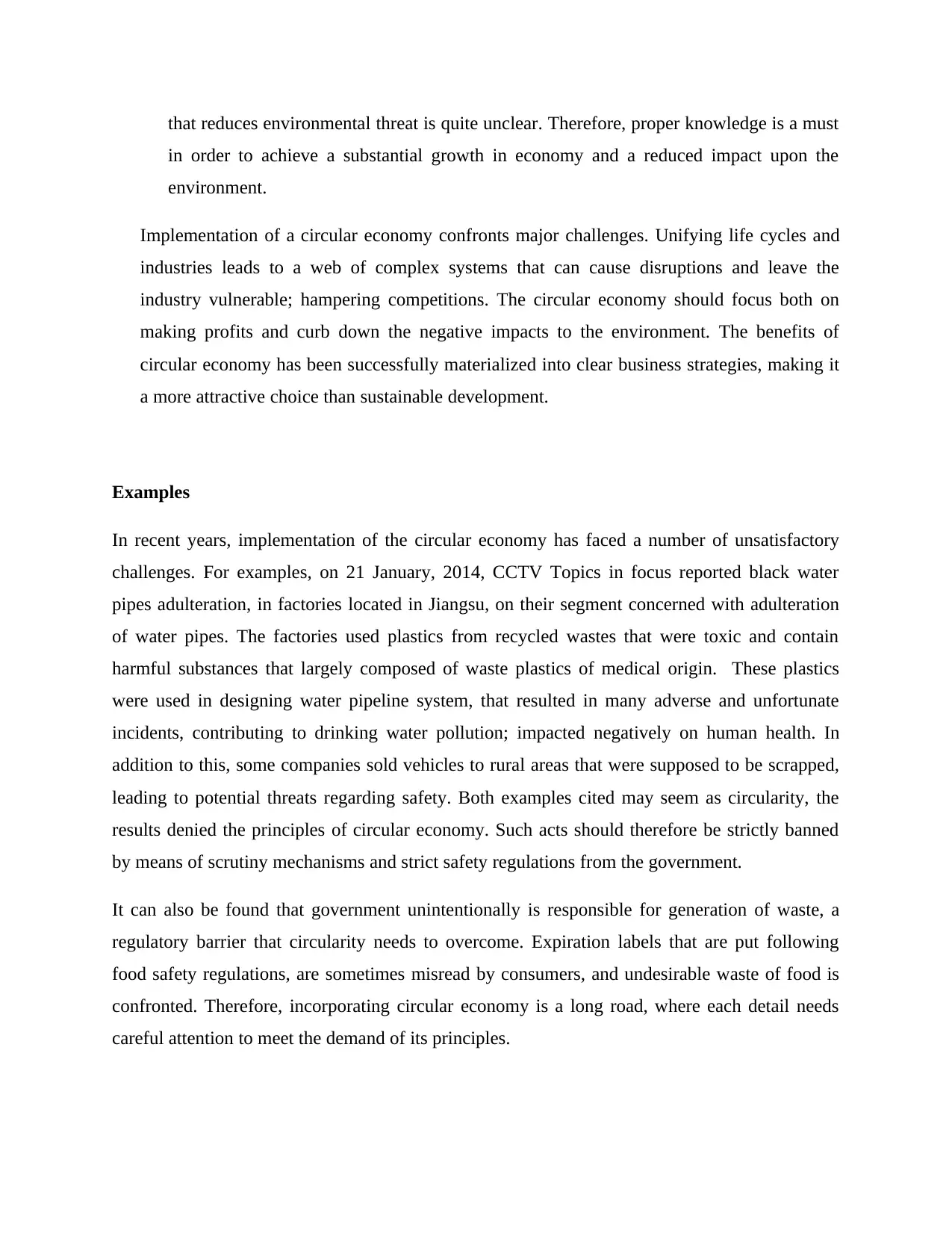
that reduces environmental threat is quite unclear. Therefore, proper knowledge is a must
in order to achieve a substantial growth in economy and a reduced impact upon the
environment.
Implementation of a circular economy confronts major challenges. Unifying life cycles and
industries leads to a web of complex systems that can cause disruptions and leave the
industry vulnerable; hampering competitions. The circular economy should focus both on
making profits and curb down the negative impacts to the environment. The benefits of
circular economy has been successfully materialized into clear business strategies, making it
a more attractive choice than sustainable development.
Examples
In recent years, implementation of the circular economy has faced a number of unsatisfactory
challenges. For examples, on 21 January, 2014, CCTV Topics in focus reported black water
pipes adulteration, in factories located in Jiangsu, on their segment concerned with adulteration
of water pipes. The factories used plastics from recycled wastes that were toxic and contain
harmful substances that largely composed of waste plastics of medical origin. These plastics
were used in designing water pipeline system, that resulted in many adverse and unfortunate
incidents, contributing to drinking water pollution; impacted negatively on human health. In
addition to this, some companies sold vehicles to rural areas that were supposed to be scrapped,
leading to potential threats regarding safety. Both examples cited may seem as circularity, the
results denied the principles of circular economy. Such acts should therefore be strictly banned
by means of scrutiny mechanisms and strict safety regulations from the government.
It can also be found that government unintentionally is responsible for generation of waste, a
regulatory barrier that circularity needs to overcome. Expiration labels that are put following
food safety regulations, are sometimes misread by consumers, and undesirable waste of food is
confronted. Therefore, incorporating circular economy is a long road, where each detail needs
careful attention to meet the demand of its principles.
in order to achieve a substantial growth in economy and a reduced impact upon the
environment.
Implementation of a circular economy confronts major challenges. Unifying life cycles and
industries leads to a web of complex systems that can cause disruptions and leave the
industry vulnerable; hampering competitions. The circular economy should focus both on
making profits and curb down the negative impacts to the environment. The benefits of
circular economy has been successfully materialized into clear business strategies, making it
a more attractive choice than sustainable development.
Examples
In recent years, implementation of the circular economy has faced a number of unsatisfactory
challenges. For examples, on 21 January, 2014, CCTV Topics in focus reported black water
pipes adulteration, in factories located in Jiangsu, on their segment concerned with adulteration
of water pipes. The factories used plastics from recycled wastes that were toxic and contain
harmful substances that largely composed of waste plastics of medical origin. These plastics
were used in designing water pipeline system, that resulted in many adverse and unfortunate
incidents, contributing to drinking water pollution; impacted negatively on human health. In
addition to this, some companies sold vehicles to rural areas that were supposed to be scrapped,
leading to potential threats regarding safety. Both examples cited may seem as circularity, the
results denied the principles of circular economy. Such acts should therefore be strictly banned
by means of scrutiny mechanisms and strict safety regulations from the government.
It can also be found that government unintentionally is responsible for generation of waste, a
regulatory barrier that circularity needs to overcome. Expiration labels that are put following
food safety regulations, are sometimes misread by consumers, and undesirable waste of food is
confronted. Therefore, incorporating circular economy is a long road, where each detail needs
careful attention to meet the demand of its principles.
⊘ This is a preview!⊘
Do you want full access?
Subscribe today to unlock all pages.

Trusted by 1+ million students worldwide
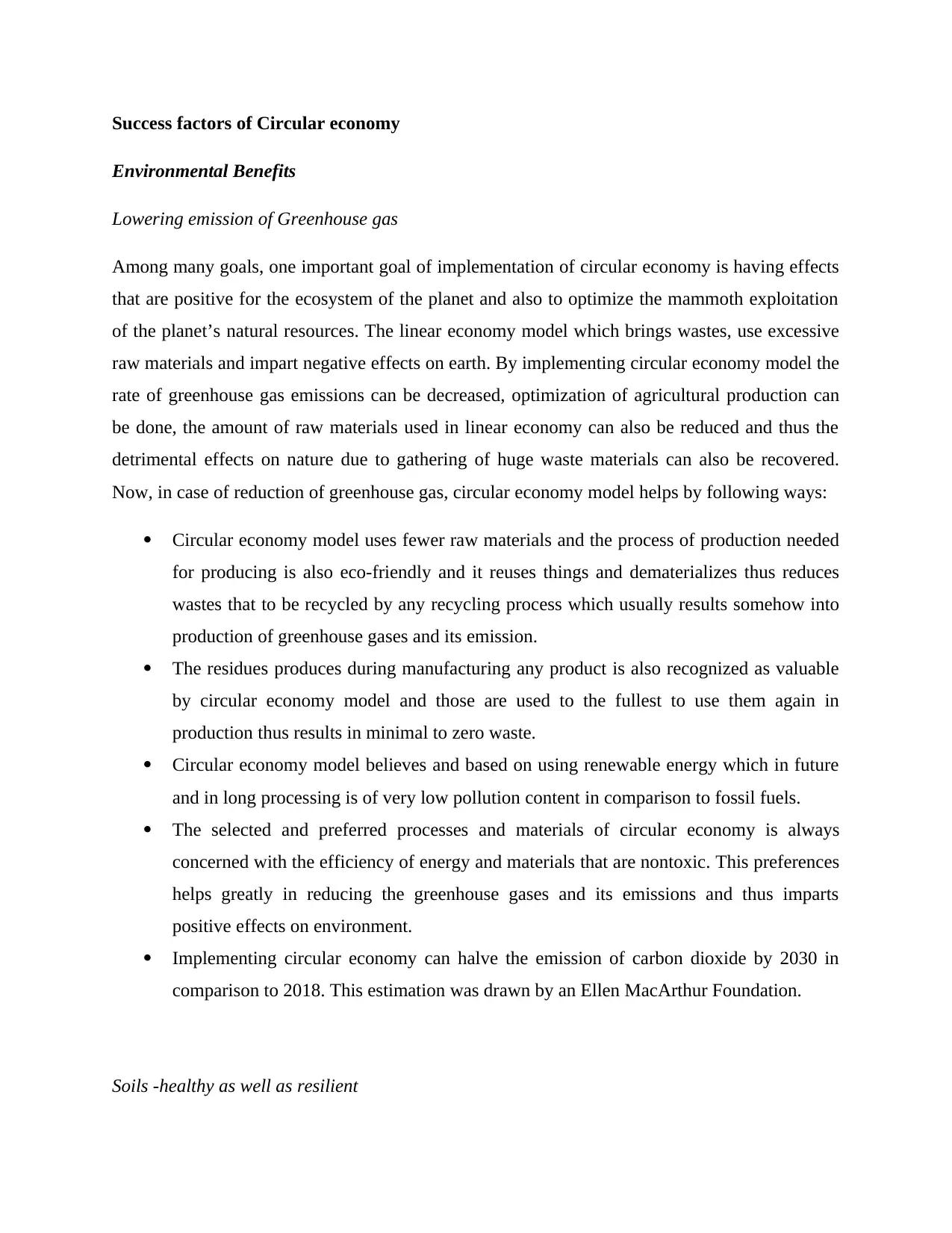
Success factors of Circular economy
Environmental Benefits
Lowering emission of Greenhouse gas
Among many goals, one important goal of implementation of circular economy is having effects
that are positive for the ecosystem of the planet and also to optimize the mammoth exploitation
of the planet’s natural resources. The linear economy model which brings wastes, use excessive
raw materials and impart negative effects on earth. By implementing circular economy model the
rate of greenhouse gas emissions can be decreased, optimization of agricultural production can
be done, the amount of raw materials used in linear economy can also be reduced and thus the
detrimental effects on nature due to gathering of huge waste materials can also be recovered.
Now, in case of reduction of greenhouse gas, circular economy model helps by following ways:
Circular economy model uses fewer raw materials and the process of production needed
for producing is also eco-friendly and it reuses things and dematerializes thus reduces
wastes that to be recycled by any recycling process which usually results somehow into
production of greenhouse gases and its emission.
The residues produces during manufacturing any product is also recognized as valuable
by circular economy model and those are used to the fullest to use them again in
production thus results in minimal to zero waste.
Circular economy model believes and based on using renewable energy which in future
and in long processing is of very low pollution content in comparison to fossil fuels.
The selected and preferred processes and materials of circular economy is always
concerned with the efficiency of energy and materials that are nontoxic. This preferences
helps greatly in reducing the greenhouse gases and its emissions and thus imparts
positive effects on environment.
Implementing circular economy can halve the emission of carbon dioxide by 2030 in
comparison to 2018. This estimation was drawn by an Ellen MacArthur Foundation.
Soils -healthy as well as resilient
Environmental Benefits
Lowering emission of Greenhouse gas
Among many goals, one important goal of implementation of circular economy is having effects
that are positive for the ecosystem of the planet and also to optimize the mammoth exploitation
of the planet’s natural resources. The linear economy model which brings wastes, use excessive
raw materials and impart negative effects on earth. By implementing circular economy model the
rate of greenhouse gas emissions can be decreased, optimization of agricultural production can
be done, the amount of raw materials used in linear economy can also be reduced and thus the
detrimental effects on nature due to gathering of huge waste materials can also be recovered.
Now, in case of reduction of greenhouse gas, circular economy model helps by following ways:
Circular economy model uses fewer raw materials and the process of production needed
for producing is also eco-friendly and it reuses things and dematerializes thus reduces
wastes that to be recycled by any recycling process which usually results somehow into
production of greenhouse gases and its emission.
The residues produces during manufacturing any product is also recognized as valuable
by circular economy model and those are used to the fullest to use them again in
production thus results in minimal to zero waste.
Circular economy model believes and based on using renewable energy which in future
and in long processing is of very low pollution content in comparison to fossil fuels.
The selected and preferred processes and materials of circular economy is always
concerned with the efficiency of energy and materials that are nontoxic. This preferences
helps greatly in reducing the greenhouse gases and its emissions and thus imparts
positive effects on environment.
Implementing circular economy can halve the emission of carbon dioxide by 2030 in
comparison to 2018. This estimation was drawn by an Ellen MacArthur Foundation.
Soils -healthy as well as resilient
Paraphrase This Document
Need a fresh take? Get an instant paraphrase of this document with our AI Paraphraser
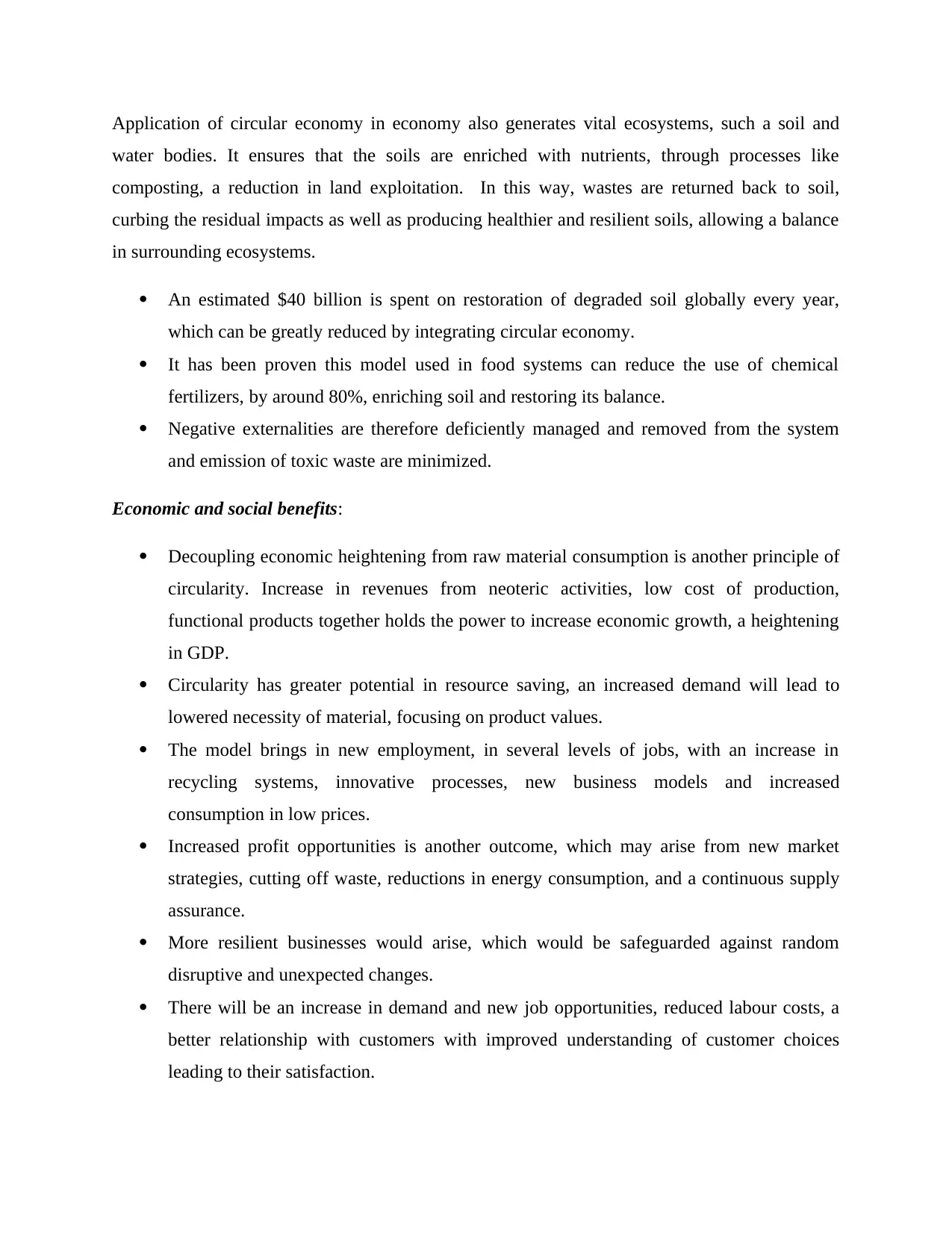
Application of circular economy in economy also generates vital ecosystems, such a soil and
water bodies. It ensures that the soils are enriched with nutrients, through processes like
composting, a reduction in land exploitation. In this way, wastes are returned back to soil,
curbing the residual impacts as well as producing healthier and resilient soils, allowing a balance
in surrounding ecosystems.
An estimated $40 billion is spent on restoration of degraded soil globally every year,
which can be greatly reduced by integrating circular economy.
It has been proven this model used in food systems can reduce the use of chemical
fertilizers, by around 80%, enriching soil and restoring its balance.
Negative externalities are therefore deficiently managed and removed from the system
and emission of toxic waste are minimized.
Economic and social benefits:
Decoupling economic heightening from raw material consumption is another principle of
circularity. Increase in revenues from neoteric activities, low cost of production,
functional products together holds the power to increase economic growth, a heightening
in GDP.
Circularity has greater potential in resource saving, an increased demand will lead to
lowered necessity of material, focusing on product values.
The model brings in new employment, in several levels of jobs, with an increase in
recycling systems, innovative processes, new business models and increased
consumption in low prices.
Increased profit opportunities is another outcome, which may arise from new market
strategies, cutting off waste, reductions in energy consumption, and a continuous supply
assurance.
More resilient businesses would arise, which would be safeguarded against random
disruptive and unexpected changes.
There will be an increase in demand and new job opportunities, reduced labour costs, a
better relationship with customers with improved understanding of customer choices
leading to their satisfaction.
water bodies. It ensures that the soils are enriched with nutrients, through processes like
composting, a reduction in land exploitation. In this way, wastes are returned back to soil,
curbing the residual impacts as well as producing healthier and resilient soils, allowing a balance
in surrounding ecosystems.
An estimated $40 billion is spent on restoration of degraded soil globally every year,
which can be greatly reduced by integrating circular economy.
It has been proven this model used in food systems can reduce the use of chemical
fertilizers, by around 80%, enriching soil and restoring its balance.
Negative externalities are therefore deficiently managed and removed from the system
and emission of toxic waste are minimized.
Economic and social benefits:
Decoupling economic heightening from raw material consumption is another principle of
circularity. Increase in revenues from neoteric activities, low cost of production,
functional products together holds the power to increase economic growth, a heightening
in GDP.
Circularity has greater potential in resource saving, an increased demand will lead to
lowered necessity of material, focusing on product values.
The model brings in new employment, in several levels of jobs, with an increase in
recycling systems, innovative processes, new business models and increased
consumption in low prices.
Increased profit opportunities is another outcome, which may arise from new market
strategies, cutting off waste, reductions in energy consumption, and a continuous supply
assurance.
More resilient businesses would arise, which would be safeguarded against random
disruptive and unexpected changes.
There will be an increase in demand and new job opportunities, reduced labour costs, a
better relationship with customers with improved understanding of customer choices
leading to their satisfaction.
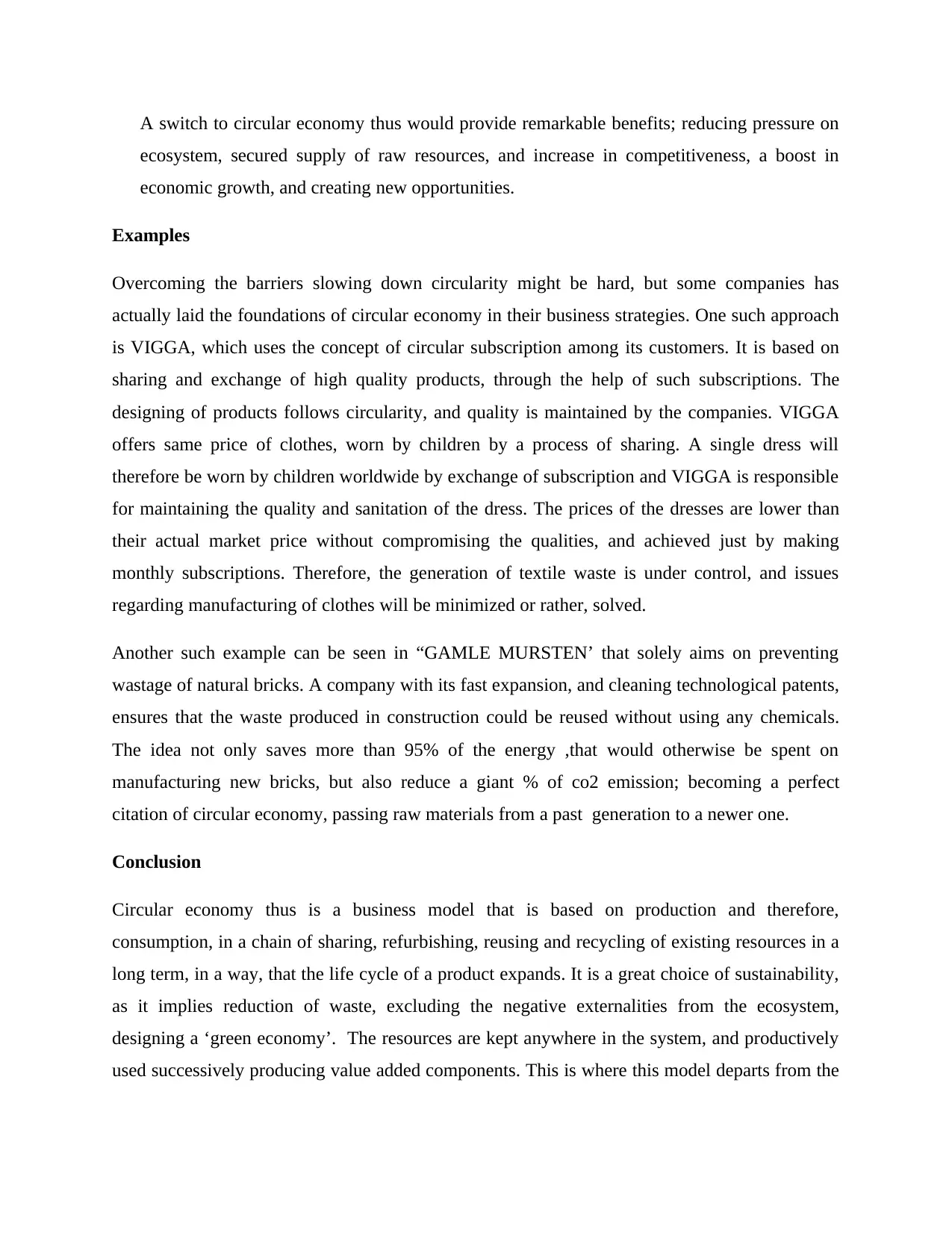
A switch to circular economy thus would provide remarkable benefits; reducing pressure on
ecosystem, secured supply of raw resources, and increase in competitiveness, a boost in
economic growth, and creating new opportunities.
Examples
Overcoming the barriers slowing down circularity might be hard, but some companies has
actually laid the foundations of circular economy in their business strategies. One such approach
is VIGGA, which uses the concept of circular subscription among its customers. It is based on
sharing and exchange of high quality products, through the help of such subscriptions. The
designing of products follows circularity, and quality is maintained by the companies. VIGGA
offers same price of clothes, worn by children by a process of sharing. A single dress will
therefore be worn by children worldwide by exchange of subscription and VIGGA is responsible
for maintaining the quality and sanitation of the dress. The prices of the dresses are lower than
their actual market price without compromising the qualities, and achieved just by making
monthly subscriptions. Therefore, the generation of textile waste is under control, and issues
regarding manufacturing of clothes will be minimized or rather, solved.
Another such example can be seen in “GAMLE MURSTEN’ that solely aims on preventing
wastage of natural bricks. A company with its fast expansion, and cleaning technological patents,
ensures that the waste produced in construction could be reused without using any chemicals.
The idea not only saves more than 95% of the energy ,that would otherwise be spent on
manufacturing new bricks, but also reduce a giant % of co2 emission; becoming a perfect
citation of circular economy, passing raw materials from a past generation to a newer one.
Conclusion
Circular economy thus is a business model that is based on production and therefore,
consumption, in a chain of sharing, refurbishing, reusing and recycling of existing resources in a
long term, in a way, that the life cycle of a product expands. It is a great choice of sustainability,
as it implies reduction of waste, excluding the negative externalities from the ecosystem,
designing a ‘green economy’. The resources are kept anywhere in the system, and productively
used successively producing value added components. This is where this model departs from the
ecosystem, secured supply of raw resources, and increase in competitiveness, a boost in
economic growth, and creating new opportunities.
Examples
Overcoming the barriers slowing down circularity might be hard, but some companies has
actually laid the foundations of circular economy in their business strategies. One such approach
is VIGGA, which uses the concept of circular subscription among its customers. It is based on
sharing and exchange of high quality products, through the help of such subscriptions. The
designing of products follows circularity, and quality is maintained by the companies. VIGGA
offers same price of clothes, worn by children by a process of sharing. A single dress will
therefore be worn by children worldwide by exchange of subscription and VIGGA is responsible
for maintaining the quality and sanitation of the dress. The prices of the dresses are lower than
their actual market price without compromising the qualities, and achieved just by making
monthly subscriptions. Therefore, the generation of textile waste is under control, and issues
regarding manufacturing of clothes will be minimized or rather, solved.
Another such example can be seen in “GAMLE MURSTEN’ that solely aims on preventing
wastage of natural bricks. A company with its fast expansion, and cleaning technological patents,
ensures that the waste produced in construction could be reused without using any chemicals.
The idea not only saves more than 95% of the energy ,that would otherwise be spent on
manufacturing new bricks, but also reduce a giant % of co2 emission; becoming a perfect
citation of circular economy, passing raw materials from a past generation to a newer one.
Conclusion
Circular economy thus is a business model that is based on production and therefore,
consumption, in a chain of sharing, refurbishing, reusing and recycling of existing resources in a
long term, in a way, that the life cycle of a product expands. It is a great choice of sustainability,
as it implies reduction of waste, excluding the negative externalities from the ecosystem,
designing a ‘green economy’. The resources are kept anywhere in the system, and productively
used successively producing value added components. This is where this model departs from the
⊘ This is a preview!⊘
Do you want full access?
Subscribe today to unlock all pages.

Trusted by 1+ million students worldwide
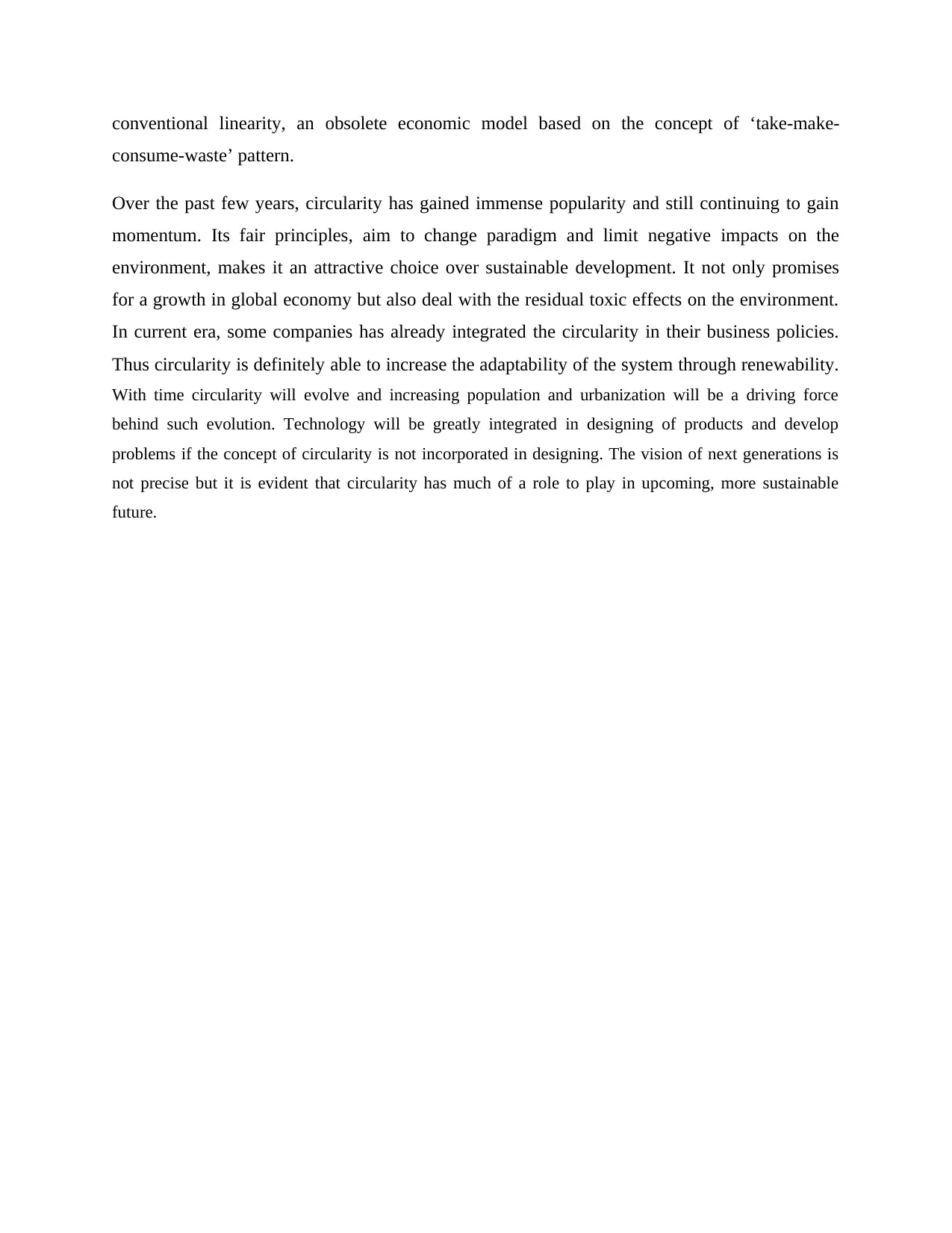
conventional linearity, an obsolete economic model based on the concept of ‘take-make-
consume-waste’ pattern.
Over the past few years, circularity has gained immense popularity and still continuing to gain
momentum. Its fair principles, aim to change paradigm and limit negative impacts on the
environment, makes it an attractive choice over sustainable development. It not only promises
for a growth in global economy but also deal with the residual toxic effects on the environment.
In current era, some companies has already integrated the circularity in their business policies.
Thus circularity is definitely able to increase the adaptability of the system through renewability.
With time circularity will evolve and increasing population and urbanization will be a driving force
behind such evolution. Technology will be greatly integrated in designing of products and develop
problems if the concept of circularity is not incorporated in designing. The vision of next generations is
not precise but it is evident that circularity has much of a role to play in upcoming, more sustainable
future.
consume-waste’ pattern.
Over the past few years, circularity has gained immense popularity and still continuing to gain
momentum. Its fair principles, aim to change paradigm and limit negative impacts on the
environment, makes it an attractive choice over sustainable development. It not only promises
for a growth in global economy but also deal with the residual toxic effects on the environment.
In current era, some companies has already integrated the circularity in their business policies.
Thus circularity is definitely able to increase the adaptability of the system through renewability.
With time circularity will evolve and increasing population and urbanization will be a driving force
behind such evolution. Technology will be greatly integrated in designing of products and develop
problems if the concept of circularity is not incorporated in designing. The vision of next generations is
not precise but it is evident that circularity has much of a role to play in upcoming, more sustainable
future.
1 out of 10
Related Documents
Your All-in-One AI-Powered Toolkit for Academic Success.
+13062052269
info@desklib.com
Available 24*7 on WhatsApp / Email
![[object Object]](/_next/static/media/star-bottom.7253800d.svg)
Unlock your academic potential
Copyright © 2020–2025 A2Z Services. All Rights Reserved. Developed and managed by ZUCOL.





